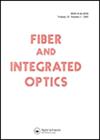Performance of Q-Switched Fiber Laser Using Optically Deposited Reduced Graphene Oxide as Saturable Absorber
IF 2.3
4区 物理与天体物理
Q2 OPTICS
引用次数: 4
Abstract
ABSTRACT Graphene is one of the most attractive two-dimensional nanomaterials widely used as saturable absorber for pulsing laser, owing to its unique non-linear optical responses. However, fabrication and integration of graphene saturable absorber into a laser cavity involves complex processes and procedures. Mass production of graphene-based saturable absorbers requires simplification of the fabrication process with minimum material wastage. Reduced graphene oxide, a functionalized graphene, is found to have saturable absorption property as well. Comparatively, it is easier and more cost-effective to produce. On the other hand, optical deposition is a saturable absorber deposition technique that maximizes material utilization. In this work, commercially available reduced graphene oxide in N-methyl-2-pyrrolidone was used to fabricate a saturable absorber device via optical deposition, due to its simplicity and high efficacy. Optical pulse generation via Q-switching were successfully demonstrated with the optically deposited rGO-SA incorporated into a ring erbium-doped fiber laser. Pulse repetition rate of up to ~85.0 kHz and pulse durations as short as ~2.0 μs were achieved. Its performance as a saturable absorber in a Q-switched fiber laser is then compared with previous works. Comparatively, optically deposited rGO has a much lower Q-switched threshold and holds huge potential for mass production with maximum material utilization.利用光沉积还原氧化石墨烯作为可饱和吸收体的调q光纤激光器性能
石墨烯由于其独特的非线性光学响应特性,被广泛用作脉冲激光的可饱和吸收材料,是目前最具吸引力的二维纳米材料之一。然而,制造和集成石墨烯饱和吸收体到激光腔涉及复杂的工艺和程序。大规模生产石墨烯基可饱和吸收剂需要简化制造工艺,并将材料浪费降到最低。还原氧化石墨烯是一种功能化的石墨烯,也具有饱和吸收特性。相比之下,它更容易生产,成本效益更高。另一方面,光学沉积是一种可饱和吸收沉积技术,可以最大限度地利用材料。在这项工作中,由于n -甲基-2-吡咯烷酮中的还原氧化石墨烯简单而高效,因此通过光学沉积制备了一种可饱和吸收装置。在环形掺铒光纤激光器中,成功地证明了通过q开关产生光脉冲。脉冲重复频率高达~85.0 kHz,脉冲持续时间短至~2.0 μs。并将其作为调q光纤激光器中可饱和吸收材料的性能与前人的研究成果进行了比较。相比之下,光沉积的氧化石墨烯具有更低的调q阈值,具有巨大的量产潜力和最大的材料利用率。
本文章由计算机程序翻译,如有差异,请以英文原文为准。
求助全文
约1分钟内获得全文
求助全文
来源期刊
CiteScore
3.40
自引率
0.00%
发文量
4
审稿时长
>12 weeks
期刊介绍:
Fiber and Integrated Optics , now incorporating the International Journal of Optoelectronics, is an international bimonthly journal that disseminates significant developments and in-depth surveys in the fields of fiber and integrated optics. The journal is unique in bridging the major disciplines relevant to optical fibers and electro-optical devices. This results in a balanced presentation of basic research, systems applications, and economics. For more than a decade, Fiber and Integrated Optics has been a valuable forum for scientists, engineers, manufacturers, and the business community to exchange and discuss techno-economic advances in the field.

 求助内容:
求助内容: 应助结果提醒方式:
应助结果提醒方式:


